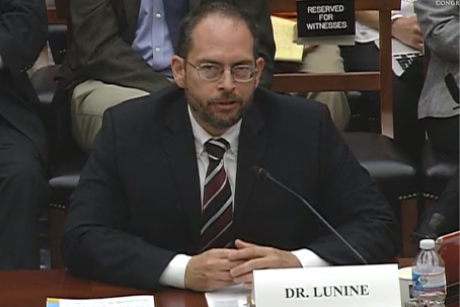Lunine says send humans to 'walk the red soil of Mars'
By Blaine Friedlander

If humans travel from this pale blue world to the red planet Mars in the next several decades, it will be the U.S. Congress that provides the green for the go-ahead.
Testifying in Washington June 25 before the House Committee on Science, Space and Technology, Jonathan Lunine, Cornell’s David C. Duncan Professor of Physical Sciences and co-chair of the Committee on Human Spaceflight of the National Research Council (NRC), and his co-chair, Mitchell E. Daniels Jr., president of Purdue University and former governor of Indiana, answered the representatives’ questions.
“Mr. Chairman, Mars really is incredibly hard,” said Lunine, but possible. He and Daniels discussed the findings in the Committee on Human Spaceflight’s 285-page report published June 4 on whether humans should continue exploring space. The NRC committee comprised a diverse national group of scientists and professionals convened by Congressional request.
They explained that the United States needed a decades-long commitment to Mars if humanity has a hope of sending astronauts to the red planet.
“We are not the first to say that our nation’s commitment to human exploration cannot change direction election after election. But in the end, our elected leaders are not the impediment to achieving great goals in space; you are the critical enablers of our nation’s investment in human spaceflight,” said Lunine.
“Only you can ensure that the leadership, personnel, governance and resources are in place that will ensure human beings will one day walk on the red soil of Mars,” Lunine added.
Congress requested the report in the 2010 NASA Authorization Act. That legislation directed the space agency to contract the NRC to conduct the study, which officially got underway in December 2012. The House passed a $17.6 billion reauthorization bill of NASA programs June 9 in a 401-2 vote.
In the report, the group provides rationales for continuing human spaceflight. The report includes strategies and suggestions on how the country could lead the long-term effort, with up to a half-century time scale.
It suggests three potential pathways that could culminate in landing on the surface of Mars. Completing any of them would require developing a number of mission elements and technological capabilities, including Mars entry, descent, landing, radiation safety and in-space propulsion, according to the report. These capabilities will be the most difficult to develop in terms of costs and technical challenges, according to the report.
For humanity to alight Mars requires decades of sustained effort and hundreds of billions of dollars, said Lunine. “To be a sustainable program, it will require a steadfast national commitment to a consensus goal, international collaboration and a budget that increases by more than the rate of inflation.” The professor reminded Congress that the hundreds of billions of dollars are stretched out over several decades.
“Getting humans to the surface of Mars will be a daunting challenge,” said Daniels. “It is immensely difficult, probably more so than most laymen and even many experts have recognized. Succeeding in this endeavor will require a very different way of doing business than the nation has been practicing in recent decades,” he said.
“It is my personal hope that our report will carry the national conversation forward in the direction of realism: realism about public opinion, about risk, about cost and about the incredibly daunting technical challenges of the horizon goal that we believe the world embraces,” said Daniels.
Media Contact
Get Cornell news delivered right to your inbox.
Subscribe